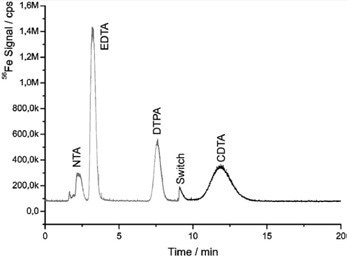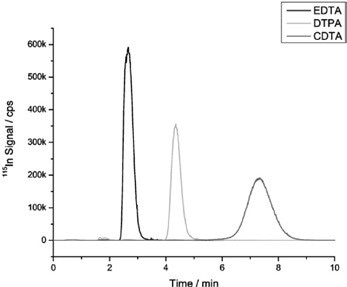Recently, organic compounds such as biomolecules and pesticides have been analyzed using the IC-ICP/MS method. This method was shown to be suitable for examining molecules of relatively small masses that are present as ions. IC-ICP/MS can also be used to monitor chelating agents, which are often used in industrial processes and have the potential to pollute the environment. Another field of application is the analysis of organophosphates in battery research (Knöll, J., 2012).
Aminopolycarboxylic acids in surface water using ion-exchange chromatography coupled to ICP/MS
Aminopolycarboxylic-acid-based chelating agents such as 1, 2-cyclohexylenedinitrilotetraacetic acid (CDTA), diethylene triamine pentaacetic acid (DTPA), ethylenediaminetetraacetic acid (EDTA) and nitrilotriacetic acid (NTA) are all agents commonly used in industrial process and household products.
These chelating agents can easily pass through the wastewater treatment plant and reach surface waters, where they are only poorly biodegradable. These agents then enter the drinking water cycle via the groundwater. Despite generally being nontoxic themselves, these chelating agents can mobilize toxic metals from the river sediments and make them biologically available.
Results
An indirect method that required only minimal sample preparation was developed for the determination of ultra-trace amounts of aminopolycarboxylic acids present in surface water. In order to convert the chelating reagents into negatively charged complexes, metal ions are added to the water sample. These complexes are then separated by ion-exchange chromatography (IC). An online coupled ICP/MS detects the complex’s central metal ion, to deduce the concentrations of the chelating agents from this. Shown in Figures 1 and 2, iron and indium were investigated as two metal ions of nominal charge +3.

Figure 1. Separation of the Fe(III) complexes of NTA, EDTA, DTPA, and CDTA in less than 15 min using column-switching.


Figure 2. Fe (III) complexes (top) and In(III) complexes (bottom) of EDTA, DTPA, and CDTA demonstrating the increased sensitivity for indium. Column 1: DV-080429-1A2 20 mm × 2 mm, PEEK, capacity 20 μmol; column 2: DV-080429-1A1 100 mm × 2 mm, PEEK, capacity 100 μmol; eluent: 20 mmol/L NH4NO3 (pH = 2); flow rate: 0.6 mL/min; m/z 56, 115.
In terms of sensitivity and detection limits in the lower ng/L range, In3+ gave the best results. Due to the low retention of the complex, the trivalent complexing agent NTA could not be accurately determined. Both iron and indium complexes of CDTA are strongly absorbed on anion exchangers and showed retention times of more than 1 hour. The retention time was decreased to less than 15 minutes by using column-switching. A sample set of 62 samples was used to validate this method. The same sample set had been previously analyzed by an external water laboratory based on the DIN EN ISO 16588 using the GC-MS technique.
Organic compounds – further applications with IC-ICP/MS
Two-dimensional ion chromatography for the separation of ionic organophosphates generated in thermally decomposed lithium hexafluorophosphate-based lithium ion battery electrolytes.
Kraft, V.; Grützke, M.; Weber, W.; Menzel, J.; Wiemers-Meyer, S.; Winter, M.; Nowak, S. (2015) J. Chrom. A 1409, 201–209
References
- Aschner, M.; Syversen, T. (2005) Methylmercury: Recent advances in the understanding of its neurotoxicity. Ther. Drug Monit. 27, 278–283.
- Bianchi, A.; Calabi, L.; Corana, F.; Fontana, S.; Losi, Maiocchi, A.; Paleari, L.; Valtancoli, B. (2000) Thermodynamic and structural properties of Gd(III) complexes with polyaminopolycarboxylic ligands: Basic compounds for the development of MRI contrast agents. Coord. Chem. Rev. 204, 309–393
- Burger, J.; Gochfeld, M. (2005) Heavy metals in commercial fish in New Jersey. Environ. Res. 99(3), 403–412
- Dietary Supplement Fact Sheet: Selenium. US National Institutes of Health; Office of Dietary Supplements. Retrieved Oct 11, 2016.
- Gochfeld, M.; Burger, J. (2005) Good fish/bad fish: A composite benefit–risk by dose curve. Neurotoxicology 26(4), 511–520
- Herrmann, T. Einsatz der On-line-Kopplung von Ionenchromatographie und ICP-MS zur Bestimmung von Anionen. Diploma thesis, Philipps-Universität Marburg, Germany, 2006
- Knöll, J. Ph.D. Ultratrace determination of aminopolycarboxylic acid based chelating agents using inverse on-line coupling of IC with ICP-MS. PhD thesis, Philipps-Universität Marburg, Germany, 2013
- Knöll, J.; Seubert, A. (2012) Indirect ultra trace determination of aminopolycarboxylic acids in surface water using ion exchange chromatography coupled on-line to inductively coupled plasma mass spectrometry. Journal of Chromatography A 1270, 219-224.
- Kümmerer, K.; Ed. Pharmaceuticals in the environment: Sources, fate, effects, and risks. Springer-Verlag Berlin Heidelberg, 2008; 3rd ed.
- Künnemeyer, J.; Terborg, L.; Meermann, B.; Brauckmann, C.; Möller, I.; Scheffer, A.; Karst, U. (2009) Speciation analysis of gadolinium chelates in hospital effluents and wastewater treatment plant sewage by a novel HILIC/ICP-MS method. Environ. Sci. Technol. 43(8), 2884–2890.
- Künnemeyer, J.; Terborg, L.; Nowak, S.; Telgmann, L.; Tokmak, F.; Krämer, B. K.; Günsel, A.; Wiesmüller, G. A.; Waldeck, J.; Bremer, C.; Karst, U. (2009) Analysis of the contrast agent Magnevist and its transmetalation products in blood plasma by capillary electrophoresis / electrospray ionization time-of-flight mass spectrometry. Anal. Chem. 81(9), 3600–3607
- Levenson, C. W.; Axelrad, D. M. (2006) Too much of a good thing? Update on fish consumption and mercury exposure Nutr. Rev. 64(3), 139–145.
- Montaser, A.; Golightly, D. W.; Eds. Inductively coupled plasmas in analytical atomic spectrometry. VCH Publishers, Inc.: New York, 1992.
- Rahman, G. M. M.; Martone, N.; 'Skip' Kingston, H. M. (2012) Determination of hexavalent chromium in NIST SRM 2701 by speciated isotope dilution mass spectrometry (EPA Method 6800) using IC-ICP-MS. In Handbook of hyphenated ICP-MS applications, 2nd edition; Agilent, 2012; pp 33–35. http://www.agilent.com/cs/library/applications/5990-9473EN_icpmsSpeciationHB_lr.pdf (accessed Oct 7, 2016)
- Saranko, C. J. et al. Fact Report for toxicity of arsenite and arsenate, Florida Dept. of Health, Nov 6, 1998
- Schedlbauer, O. F.; Heumann, K. G. (2000) Biomethylation of thallium by bacteria and first determination of biogenic dimethylthallium in the ocean. Appl. Organomet. Chem.14(6), 330-340
- Wilber, C. G. (1980). Toxicology of selenium: A review.Clin. Toxicol. 17 (2), 171–230.
About Metrohm
At Metrohm is one of the world’s most trusted manufacturers of high-precision instruments for chemical analysis. Metrohm was founded in 1943 by engineer Bertold Suhner in Herisau, Switzerland. Today, Metrohm is represented in 120 countries by subsidiaries and exclusive distributors. The global Metrohm Group also includes the Dutch companies Metrohm Applikon and Metrohm Autolab, manufacturers of online analyzers and instruments for electrochemical research, respectively. Recently, the Metrohm Group was joined by Metrohm Raman, a leading manufacturer of handheld Raman spectrometers.
Metrohm is the global market leader in analytical instruments for titration. Instruments for ion chromatography, voltammetry, conductivity, and stability measurement make the Metrohm portfolio for ion analysis complete. Instruments for Near-infrared and Raman spectroscopy are another, strongly growing segment of the Metrohm portfolio.
Metrohm is a problem solver, both in the laboratory and within the industrial process. To this end, the company offers their customers complete solutions, including dedicated analytical instrumentation as well as comprehensive application know-how. More than 30% of the company’s employees at the Metrohm international headquarters in Herisau work in R&D.
Metrohm has been owned 100% by the non-profit Metrohm Foundation since 1982. The Metrohm Foundation, which does not exert any influence on the company’s business operations, sponsors gifted students in the natural sciences, supports charitable and philanthropic purposes and, above all, ensures the independence of the company.
Sponsored Content Policy: News-Medical.net publishes articles and related content that may be derived from sources where we have existing commercial relationships, provided such content adds value to the core editorial ethos of News-Medical.Net which is to educate and inform site visitors interested in medical research, science, medical devices and treatments.